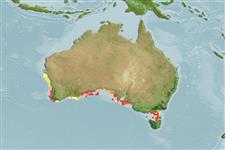>
Gadiformes (Cods) >
Moridae (Morid cods)
Etymology: Eeyorius: Taken from Eeyore, in Winnie the Pooh; both personages (the fish and literarian) live in damp dark places (Ref. 45335).
Environment: milieu / climate zone / depth range / distribution range
Écologie
marin démersal; profondeur 8 - 12 m (Ref. 1371). Subtropical; 27°S - 42°S, 112°E - 150°E (Ref. 1371)
Indo-Pacific: five localities in the Australian states of Western Australia, Victoria and Tasmania.
Taille / Poids / Âge
Maturity: Lm ? range ? - ? cm
Max length : 26.0 cm TL mâle / non sexé; (Ref. 1371)
Épines dorsales (Total): 0; Épines anales 0. Outer teeth in upper jaw only slightly larger than others; those on lower jaw of equal size. Light organ absent. Color in preservative brownish gray, lighter on ventral portions of the head; fins uniformly brownish gray.
A benthic species which occurs in inshore waters (Ref. 75154). Described from the original literature only (Ref. 1371).
Life cycle and mating behavior
Maturité | Reproduction | Frai | Œufs | Fécondité | Larves
Cohen, D.M., T. Inada, T. Iwamoto and N. Scialabba, 1990. FAO species catalogue. Vol. 10. Gadiform fishes of the world (Order Gadiformes). An annotated and illustrated catalogue of cods, hakes, grenadiers and other gadiform fishes known to date. FAO Fish. Synop. 125(10). Rome: FAO. 442 p. (Ref. 1371)
Statut dans la liste rouge de l'IUCN (Ref. 130435)
Menace pour l'homme
Harmless
Utilisations par l'homme
Pêcheries: sans intérêt
Plus d'informations
Noms communsSynonymesMétabolismePrédateursÉcotoxicologieReproductionMaturitéFraiRassemblement de ponteFéconditéŒufsDéveloppement de l'œuf
Taille/ÂgeCroissanceLongueur-poidsLongueur-longueurFréquences de longueursMorphométrieMorphologieLarvesDynamique des populations larvairesRecrutementAbondanceBRUVS
RéférencesAquacultureProfil d'aquacultureSouchesGénétiqueElectrophoresesHéritabilitéPathologiesTraitementNutrientsMass conversion
Outils
Articles particuliers
Télécharger en XML
Sources Internet
Estimates based on models
Preferred temperature (Ref.
123201): 15.1 - 21.7, mean 17.3 °C (based on 149 cells).
Phylogenetic diversity index (Ref.
82804): PD
50 = 1.0000 [Uniqueness, from 0.5 = low to 2.0 = high].
Bayesian length-weight: a=0.00389 (0.00195 - 0.00776), b=3.11 (2.93 - 3.29), in cm total length, based on LWR estimates for this (Sub)family-body shape (Ref.
93245).
Niveau trophique (Ref.
69278): 3.4 ±0.4 se; based on size and trophs of closest relatives
Résilience (Ref.
120179): Milieu, temps minimum de doublement de population : 1,4 à 4,4 années (Preliminary K or Fecundity.).
Fishing Vulnerability (Ref.
59153): Low vulnerability (16 of 100).
